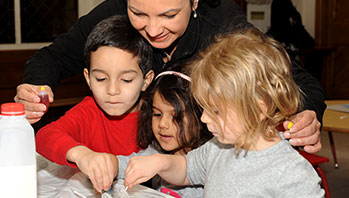- children’s bean seed, grass seed, and onion bulb plants
- magnifying lenses
- science notebooks
- bulb
- leaves
- plant
- root
- stem
- vein
MA Standards:
Mathematics/Counting and Cardinality/PK.CC.MA.3: Understand the relationships between numerals and quantities up to ten.
Mathematics/Measurement and Data/PK.MD.MA.1: Recognize the attributes of length, area, weight, and capacity of everyday objects using appropriate vocabulary (e.g., long, short, tall, heavy, light, big, small, wide, narrow)
Head Start Outcomes:
Logic and Reasoning/Reasoning and Problem Solving: Classifies, compares, and contrasts objects, events, and experiences.
Science Knowledge/Scientific Skills and Method: Uses senses and tools, including technology, to gather information, investigate materials, and observe processes and relationships.
Science Knowledge/Scientific Skills and Method: Observes and discusses common properties, differences, and comparisons among objects.
Science Knowledge/Scientific Skills and Method: Collects, describes, and records information through discussions, drawings, maps, and charts.
PreK Learning Guidelines:
Science and Technology/Inquiry Skills 3: Identify and use simple tools appropriately to extend observations.
Science and Technology/Inquiry Skills 4: Record observations and share ideas through simple forms of representation such as drawings.
Small Group: Plant Leaves

© Commonwealth of Massachusetts, Department of Early Education and Care (Jennifer Waddell photographer). All rights reserved.
STEM Key Concepts: Plants start in different ways; Some plants start from seeds; Some plants start from bulbs; Plants have different parts: roots, stems, leaves, and fruit
ELA Focus Skills: Listening and Speaking, Vocabulary
Safety Tips:
- Remind children to wash their hands before and after the activity.
- Remind children not to eat ANY plants or touch any plants without asking an adult.
- Take children’s allergies into account before going outside.
Tell children they are going to continue observing how their plants are growing and changing. Have them focus on the leaves of their bean, grass, and onion bulb plants. Start by having children count the leaves growing from each of the onion bulbs. Help them record the findings in their science notebooks.
Then discuss different things about the leaves that children can observe. You may want to make a list of children’s ideas. They may include:
- Smell the leaves
- Look at the veins in the leaves
- Look at the size of the leaves
- Measure the leaves
- Compare the color of the leaves
- Look at the shape of the leaves
- Count how many leaves
Distribute magnifying lenses and have children work together to explore the plants. Help them to record changes and new findings about leaves in their notebooks. As children explore, notice things that catch their attention and engage them by asking questions such as,
- How do the onion leaves smell compared to the grass or bean leaves? (more smelly, stronger)
- What do you notice about how the bean plant leaves grow?
- What plant has the biggest leaves? The most leaves?
Once children have observed the leaves of the plants more closely, have them add the details to their drawings.
Take it Further: Reinforce the idea that the same word can mean different things. Hold up your hand and point to a vein. Tell children that the veins in an animal’s body carry blood to all parts of the body. Now hold up a leaf and point to the vein. Ask children what role they think the veins in a leaf play in helping the plant grow. (brings food and water to all part of the plant)
Take It Further: Show children pictures of a variety of leaves from other plants that they may not be familiar with. Encourage them to make comparisons between the leaves in the pictures. Ask them if they have any questions about the leaves. Do they wonder why some leaves are bigger than others? Why some are different colors? As children ask questions, ask them to think about how they can find the answers to their questions.
